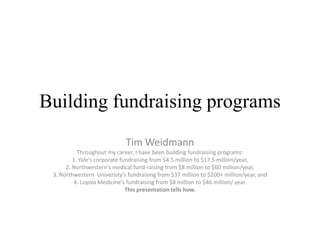Building Fundraising Programs
- 1. Building fundraising programs Tim Weidmann Throughout my career, I have been building fundraising programs: 1. Yale’s corporate fundraising from $4.5 million to $17.5 million/year, 2. Northwestern’s medical fund-raising from $8 million to $60 million/year, 3. Northwestern University’s fundraising from $37 million to $200+ million/year, and 4. Loyola Medicine’s fundraising from $8 million to $46 million/ year. This presentation tells how.
- 2. Corporate gifts for Yale • Researched best practices for corporate giving, then implemented those practices – Doubled corporate giving • But came to believe Yale could raise more • Researched state-of-the-art corporate giving nationwide – Discovered creative techniques at MIT, Wash U, Stanford, and Harvard
- 3. State-of-the-art Techniques • To utilize the MIT/Wash U/Stanford/Harvard techniques, worked closely with Yale’s Office of Grants and Contracts (sponsored programs) • Developed a corporate agreement that provided general research dollars to departments for “first right of refusal” on any patents they developed – Using this technique, again doubled corporate giving – So overall quadrupled corporate fundraising at Yale
- 4. Northwestern’s medical fund-raising: $8M to $60M/year • Med School stuck at raising $8M/year • Converted Med School fundraising to wealthy grateful patients – Worked initially with Department chairs to identify wealthy grateful patients • After raising 3 mega-gifts, top physicians at Med School began telling Development Office of their wealthy grateful patients – After five years, medical school was raising $60M/year
- 5. Quintupling Northwestern Fundraising • Story has many aspects • Arrived at Northwestern in 1987, when University had raised $37M – Left Northwestern in 2001 raising $200M • Believed Northwestern had the potential to raise at least as much as University of Chicago – To build the fundraising program took: a. Internal organization b. Internal team building b. External expectations of alumni and friends
- 6. a. Internal team building (1) • Initially built strong fundraising teams for Medical and Law Schools – Both Schools had strong potential for fundraising – Both could be used as models for other schools to emulate • Built medical program on grateful patient gifts • Built law program in three parts: – Tripled the annual fund – Recruited key volunteers – Solicited named chairs from wealthy alumni and local firms
- 7. b. Internal Organization (1) • In 1987, Northwestern could not be char- acterized as “best practices” fundraising shop • Re-engineered Prospect Research department – Used top researcher from Harvard as counsel – Transformed department to best practices – Hired new Director, recruited mostly new staff
- 8. b. Internal Organization (2) • Brought PCs onto desks of all fundraisers – Automated Development Office using Ethernet networking • For the first time shared files, shared printers, used email, used templates, and trimmed clerical staff • Automated prospect management – Incorporated Prospect Research analysis, defined prospect “ownership,” determined prospect lists, defined stages of interaction
- 9. b. Internal Organization (3) • Defined stewardship process and require- ments – No gift >$25,000 goes unstewarded – The larger the gift, the more elaborate the stewardship • Wrote RFP for new Development database – University purchased BSR Advance for $billion campaign
- 10. a. Internal Team Building (2) • Continual recruitment of fundraisers at all levels, and restructuring as needed • Constant mentoring of staff – Goal = find and keep top performers • Organizational limits to making that happen • The more we raised, the more we attracted good fundraisers
- 11. c. External Expectations of Alumni and Friends • Built good communication with alumni and friends – The alumni magazine, school newsletters, campaign newsletters, letters from the President, university annual reports • Articles about large gifts were key – So alumni and friends who were capable of doing the same were “shown the way” • Constant message = importance of private philanth- ropy to maintain and enhance university excellence – Alumni and friends came to expect philanthropy in a big way
- 12. Conclusion with Northwestern • Created a Culture of Philanthropy – Throughout the university over 14 years • Undertook 12 specific and sweeping actions to bring Northwestern’s fundraising from $37M to $200+M/year – Actions were all team efforts – Would have failed, if I weren’t a team player
- 13. Built Loyola Medical Fundraising • Was hired to create independent medical fundraising arm • 7 staff members when I arrived, and Medical Development Office raising $8M/year – 31 professionals, when I left, raising $46M/year • Variables to create results with: CFR and individual fundraising, wealthy grateful patients, Med School, hospital, coming campaign
- 14. Loyola Medical Center • Introduced best practices – Created hospital annual fund – Increased and stabilized Med School annual fund – Quadrupled CFR fundraising for Med School – Built patient database • Did wealth-screening to identify wealthy patients – Worked with Department chairs to identify wealthy grateful patients – Wealth-screened Med alumni for wealthy alums – Defined prospects and met with them regularly
- 15. Loyola Medical Center • Communicated effectively with external constituencies – Publicized large gifts and importance of private philanthropy to excellence of medical center • Created internal Culture of Philanthropy – Appeared before faculty regularly to expound the value of philanthropy • Drove campaign planning for $300M medical research campaign
- 16. Conclusion • Why so successful at building fundraising programs? – Had excellent liberal arts education • Believe in value of American philanthropy – Got strong business education at IBM • Robust technology training at IBM – Extensive sales experience throughout college and grad school – AND with IBM • HAD to succeed – Worked for institutions I believed in – Extensive fundraising experience • “Success breeds success”















